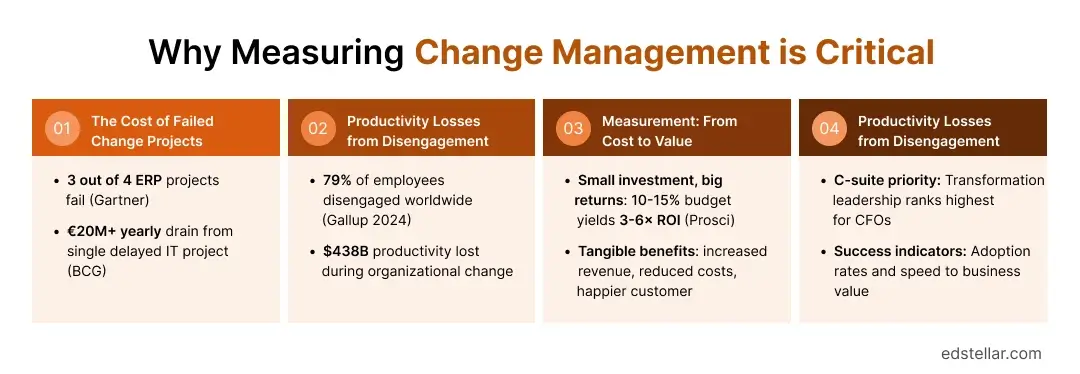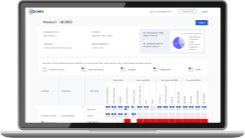
Let’s face it: you can’t just wing change management anymore. Leaders want hard proof that your efforts are paying off. That’s where measuring outcomes comes in. It’s not just a nice-to-have; it’s the backbone of making change work. By tracking the right key performance indicators (KPIs), you can spot problems early, show real results, and prove the value of your work.
Research from Prosci shows effective change management can deliver 3–6× the return on investment of a project. In contrast, the often-quoted “70% of changes fail.” This statistic reminds us that failure is common without discipline. Besides, projects with solid change management are six times more likely to hit their goals than those with poor change practices..
Change itself is a core capability in today’s economy, driven by relentless digital transformation, shifting market dynamics, and increasing regulatory demands. Done right, change can be a game-changer for your business. Organizations that master change gain a competitive edge, turning disruption into opportunity. BCG points out that a single botched IT project can bleed a company over €20 million a year.
By tracking things like adoption rates or how well your leaders are steering the ship, you turn change from a risky bet into a strategic win. Measuring KPIs ensures your change efforts deliver real value, cut down on risks, and set your organization up to handle transformation like a pro.
In this blog, we break down 12 essential KPIs to measure change management success, giving you a clear roadmap to boost ROI, track progress, and make change a competitive edge. Along the way, we’ll share corporate training solutions to help turn change into a strategic advantage.
Why Measuring Change Drives Strategic Success
Before diving into metrics, it’s critical to understand why measurement is a strategic necessity. Poorly managed change isn’t just a minor setback; it’s a bottom-line drain.
The Cost of Poor Change Management
1. The Cost of Failed Change Projects
Failed change projects are initiatives like new software rollouts or process overhauls that miss goals, run over budget, or derail entirely.
- Over 75% of ERP (Enterprise Resource Planning) software projects fail, per Gartner, causing delays, rework, and wasted resources.
- A single delayed or off-track IT project can cost a company €20M+ per year, says BCG.
Takeaway: Mismanaged change projects lead to massive financial losses.
2. Productivity Losses from Disengagement
Disengagement happens when employees feel unsupported or confused during change, reducing their output.
- Only 21% of employees worldwide are highly engaged, per Gallup (2024).
- Disengagement during change costs $438B globally in lost productivity.
- Full employee engagement could add $9.6T to global productivity.
Takeaway: Poor change management lowers morale and wastes effort.
3. Measurement: From Cost to Value
Measuring change tracks progress and success to ensure projects deliver results.
- Spending 10–15% of a project’s budget on change management yields 3–6× return on investment (according to Prosci).
- Measurable wins include higher sales, lower costs, and better customer satisfaction (e.g., improved Net Promoter Score).
Takeaway: Tracking change turns it into a profitable investment.
4. Building Executive Confidence
Clear metrics show leaders that change projects are worth the investment.
- CFOs rank leading change and transformation as a top priority.
- Metrics like user adoption rates (e.g., % of staff using new tools) and time-to-value (how fast benefits appear) tie change to business goals.
Takeaway: Data-driven change wins trust and secures funding.

The Three-Level Measurement Framework
A proven model from Prosci clarifies how to break down change outcomes into measurable layers. Prosci recommends a three-level framework for metrics: Organizational performance (overall business results), Individual performance (employee adoption and usage), and Change management performance (execution of change activities).
Each level asks distinct questions: Did the project deliver its objectives? (Organizational), Did people adopt and use the change? (Individual), And how well was the change process managed? (Change management). By measuring all three, leaders get a full picture of success.
To clarify Prosci’s three-level measurement framework, consider an example: an organization rolls out new CRM software, and the table below outlines how each level is measured, with specific metrics and their impact, showing how well-executed activities lead to adoption and drive business results.
To clarify Prosci’s three-level measurement framework, consider an example: an organization rolls out new CRM software, and the table below outlines how each level is measured, with specific metrics and their impact, showing how well-executed activities lead to adoption and drive business results.
In Prosci’s words, “organizational and individual performance measure outcomes, while change management performance measures activities.” Together, these layers form a cascade: well-executed change activities enable individual adoption, which in turn drives the organizational results (meeting targets, generating ROI).
The Essential 12 KPIs of Change Management
To implement the three-level framework, business leaders typically track a core set of 12 KPIs, grouped into strategic impact, operational adoption, and risk/control categories:
.webp)
Business Impact KPIs
- Change Success Rate: The percentage of change initiatives that meet or exceed defined objectives. This is the ultimate gauge: how many projects achieved their goals? Prosci’s research correlates this directly with change execution. For example, nearly 88% of projects with excellent change management met objectives, versus only 13% of projects with poor change management. Tracking this KPI over time (by business unit, project type, etc.) shows whether change processes are improving.
- Return on Investment (ROI): Financial return from the change divided by its cost. ROI captures the dollar impact of a change. While calculating ROI on change management alone can be complex, leaders compare total project ROI with and without change interventions. Prosci data suggests well-managed projects can deliver 3×–6× ROI compared to baseline expectations. CFOs often use ROI to justify change budgets, so this KPI should include tangible benefits (e.g., cost savings, new revenues) tied to the change.
- Revenue Impact & Cost Avoidance: This metric assesses the top-line gains and bottom-line savings attributable to the change. It can combine increased revenues (from new capabilities or markets) with avoided costs (e.g., process efficiencies, lower headcount). For instance, a company might track incremental sales revenue from a new product or annualized savings from process automation. While not all benefits are immediate, case studies show major changes can yield millions in value when tracked properly. (For example, smart digital initiatives often pay back many multiples of their investment.)
- Time to Value: The time from project start (or go-live) to when the business sees measurable benefits. Shorter time-to-value is better. Organizations using Agile and Lean methods often benchmark this to ensure changes are delivered quickly. For example, if a process improvement was expected to save $1M/year, time-to-value is the time taken to realize those savings. Tracking this KPI pushes teams to focus on early wins and incremental delivery.
Adoption & Performance KPIs
- User Adoption Rate: The proportion of intended users who are actively using the new solution or process. Rooted in Rogers’ Diffusion of Innovation, the adoption rate measures how many people have adopted the change out of those impacted. For a software deployment, this might be the percentage of employees logging in regularly. Benchmark goals (often 70–90% adoption) can be set, and a rising adoption curve indicates momentum. Vendors and SaaS firms often track this closely.
- Employee Engagement & Satisfaction: How engaged and satisfied staff are during/after the change. Engagement surveys can be used to gauge morale and buy-in. Gallup research shows engagement drives performance (with only ~21% of workers highly engaged worldwide), so a drop in engagement during change is a red flag. Post-change, satisfaction surveys (e.g., NPS or tailored questionnaires) reveal whether employees feel the change helped them. High satisfaction correlates with smoother adoption.
- Training Effectiveness: Measures the impact of change-related training. Common approaches include pre- and post-training assessments, completion rates, and behavioral metrics. For example, one KPI might be the percentage of employees who pass a knowledge test after training. Another is the percentage of attendees applying new skills within 30 days. While softer than hard ROI, this KPI is critical to ensure that people truly “learn” the change. Effective training can accelerate change adoption significantly.
- Stakeholder Satisfaction: Reflects how sponsors, managers, and key stakeholders rate the process. Often gathered via surveys or interviews, this metric asks stakeholders (e.g., the steering committee, functional heads) whether they believe the change is on track, well-communicated, and delivering value. High stakeholder satisfaction usually means the right messages are being delivered to decision-makers, which can translate to continued sponsorship.
Risk & Quality KPIs
- Change Compliance Rate: The percentage of users or processes compliant with the new requirements. For regulatory or process changes, this measures adherence. For example, after a policy update, compliance could be the percentage of transactions meeting the new standard. In IT change management (ITIL), compliance metrics track whether engineers followed the approved change process. Low compliance flags quality issues; high compliance indicates control.
- Change-Induced Downtime: Total time systems or services are unavailable due to a change, including planned and unplanned outages. Measured in minutes/hours for IT, or productivity loss for organizational changes. Low downtime means good planning and execution.
- Cost of Quality (CoQ): Total cost to ensure change quality, covering prevention (training, planning), appraisal (testing), and failure costs (rework, fixes). Track as a percentage of the change budget. Higher prevention/appraisal costs indicate proactive quality management.
- Defect Rate: Number of errors or issues per unit of change (e.g., per 1000 lines of code or process step). Track defects found during testing and after implementation. Lower rates show better quality assurance and process maturity.
Each of these KPIs should be tied back to strategic goals and measured consistently. By tracking all 12, leaders get a panoramic view of change performance, from high-level ROI to granular adoption details. Together, they form a balanced scorecard of change success, covering strategic benefits, operational uptake, and risk control.
How Corporate Training Supports Change Success
Effective training is a cornerstone of change adoption. Well-designed corporate training programs prepare teams to implement change smoothly and measure success metrics effectively. For example, specialized courses from Edstellar’s Corporate Change Management Training Course or Corporate Driving Change Training Course provide structured learning on the tools, models, and KPIs discussed above.
These programs teach participants to establish clear success definitions, develop adoption plans, and use real-world simulations to practice communication and stakeholder alignment. Embedding training into the change process ensures people have the knowledge and mindset to achieve the target KPIs; increasing adoption rates, reducing resistance, and ultimately boosting ROI.
In other words, corporate training helps turn the theory of metrics into practical expertise, making change success in everyone’s capability.
Advanced Measurement Strategies for Business Leaders
Basic measurement of change management, such as tracking simple metrics like completion rates or initial adoption, falls short of delivering strategic impact. Advanced measurement strategies are critical to navigate the complexity of large-scale transformations, ensure precise attribution of outcomes, and maximize ROI.
As changes grow in scope and speed, driven by digital innovation and market pressures, leaders need sophisticated tools to uncover hidden risks, validate investments, and drive continuous improvement. By moving beyond surface-level data, savvy leaders transform measurement into a proactive tool for sustained success.
Let’s discuss advanced measurement strategies for business leaders to enhance change management outcomes to ensure accurate outcome attribution, and maximize ROI.
Leveraging Technology and Tools for Advanced Measurement
To effectively measure complex change initiatives, organizations must harness modern technology and tools designed for data integration, real-time analytics, and scalability. Business intelligence (BI) platforms, such as Tableau or Power BI, enable leaders to consolidate data from diverse sources such as HR systems, project management software, and employee surveys into actionable insights.
Change management platforms, like Prosci’s ADKAR-based tools or ServiceNow’s change modules, streamline KPI tracking by aligning metrics with change frameworks.
Additionally, HR analytics tools (e.g., Workday or SAP SuccessFactors) can automate the collection of employee engagement and adoption data, while survey platforms like Qualtrics provide real-time feedback analysis. These tools create a robust infrastructure for measurement, ensuring data accuracy, accessibility, and alignment with strategic goals.
By selecting and integrating the right technologies, organizations lay the groundwork for advanced measurement, enabling seamless tracking of the 12 KPIs discussed in this blog.
Building Your Measurement Dashboard
Set up a centralized dashboard of KPIs for real-time visibility. Use SMART objectives (Specific, Measurable, Achievable, Relevant, Time-bound) to frame each metric and assign clear ownership. Combine leading indicators (like training completion) with lagging indicators (like ROI) in a balanced scorecard. Many organizations use BI tools or change management platforms to integrate data from surveys, HR systems, and project plans. The goal is a single pane of glass where executives can see progress on all 12 KPIs at a glance, filterable by project or timeframe.
ROI Calculation Mastery
Beyond simple ROI, factor in intangibles. Advanced approaches allocate portions of benefits to the “people side” of projects, as in Prosci’s model. For example, one can estimate the people-dependent ROI by surveying sponsors about what percentage of outcomes depends on user adoption (and conversely, how much budget is allocated to driving that adoption). This gap highlights underinvestment.
Techniques like Employee Lifetime Value (ELTV) also help: for instance, retaining a skilled worker due to a smoother change might be valued in terms of hiring/training costs saved. While complex, doing this analysis impresses finance teams and justifies further change investment.
Data Collection & Analysis Best Practices
Use sound research methods to ensure metrics are valid. Where possible, implement control groups or phased rollouts to compare impacted vs. untouched units (quasi-experimental design). Always measure metrics consistently (e.g., same survey questions) so that year-over-year comparison is fair. Ensure sample sizes are large enough for statistical confidence. Adopt data governance principles that are clean, single sources of truth, so that KPI tracking isn’t derailed by poor data.
Finally, practice attribution carefully: for example, if sales improve after a CRM launch, strip out market trends or seasonality to isolate the change’s effect. Triangulating metrics (looking at multiple KPIs for the same outcome) also reduces bias. Treat measurement itself as an iterative process: regularly review which KPIs are most predictive of success and refine them.
Avoiding Common Measurement Pitfalls
Even with a solid plan, watch out for traps that can undermine your metrics:
- Executive-Level Mistakes: Leaders sometimes fixate on “vanity metrics” (e.g., number of training sessions held) rather than outcomes. Instead, focus on actionable KPIs that tie to results. Also, beware of scope creep: measuring too many things dilutes effort. Stick to the critical metrics agreed up front.
- Data Quality Issues: Garbage in, garbage out. Inconsistent definitions (e.g., what constitutes “trained” vs. “certified”), duplicate data sources, or survey fatigue can skew KPIs. Establish clear data governance and audit your measurement process. If results look off (e.g., adoption rate jumping erratically), investigate data integrity before concluding.
- Organizational Barriers: A culture that doesn’t value transparency can stymie measurement. For example, if managers fear the punitive use of metrics, they might under-report issues. Combat this by framing KPIs as learning tools, not scorecards of blame. Encourage a data-driven culture by rewarding teams that surface problems early. Also watch for silo thinking. Ensure HR, finance, and operations share responsibility for metrics, not just the change team.
As a case in point, neglecting the people's side of projects can trigger hidden costs. Prosci notes that ineffective change management leads to “rework, redesign, rescoping, and other consequences” that inflate timelines and budgets. In other words, measuring poorly can itself cost you more in surprises later. By contrast, disciplined tracking of the right KPIs prevents these issues, protecting both schedule and ROI.
Tools & Technology for Change Measurement
Modern software can help gather and visualize change KPIs:
- Platform Selection & Integration: Many organizations use project management or HR analytics tools to capture data. When choosing platforms, evaluate how well they integrate with existing HRMS, CRM, and BI systems. Gartner and Forrester suggest using a framework (like Magic Quadrant criteria) to compare tools on data connectivity, dashboarding, and collaboration features. For example, a change platform that plugs into your HRIS can automatically update employee data for adoption metrics. A strong analytics tool can combine financial data and survey responses on one dashboard.
- Building Organizational Measurement Capability: Change isn’t just a project task; it’s an organizational skill. Form cross-functional teams (change, HR, IT, finance) that own the measurement process. Ensure leaders (especially HR and Finance) partner with change teams to interpret KPIs in context (e.g. HR can explain attrition trends, Finance can validate cost-benefit calculations).
Invest in training your analytics team on change-specific questions (for example, time-to-value analysis or engagement modeling). Over time, embed measurement experts within business units so each team learns to set and track its change metrics.
- Creating a Measurement Culture: Foster an environment where data-driven decisions are the norm. Encourage transparency by publishing KPI results across the organization (for example, a change scoreboard in all-hands meetings or intranet). Use “metrics champions” who advocate best practices in measurement.
A mature culture even uses metrics as a dialogue starter: celebrating when targets are met, and treating misses as joint problem-solving opportunities. The ultimate goal is that every leader uses change KPIs in boardroom discussions, making successful change management a true strategic advantage.
Conclusion: Transforming Change Management into Strategic Advantage
Successful organizations don’t treat change management as guesswork they treat it as a measurable, strategic discipline. By defining 3–5 clear success metrics and tracking them across the project lifecycle, businesses can move from reactive problem-solving to proactive, data-driven optimization.
The 12 KPIs covered in this guide help answer crucial questions:
- Did we achieve our financial and operational goals?
- Were employees truly engaged throughout the process?
- How effectively did we manage the transition from planning to execution?
When linked to measurable outcomes like ROI, time-to-value, or stakeholder alignment, these KPIs drive visibility, accountability, and real-time course correction.
But identifying metrics is only part of the solution. The real value lies in your team’s ability to consistently measure, analyze, and act on them something many organizations struggle with.
That’s where a trusted partner like Edstellar comes in.
Edstellar’s instructor-led Corporate Change Management Training helps teams master the frameworks, tools, and habits needed to lead measurable, sustainable change. Delivered by industry experts and customized to your goals, it transforms capability into competitive edge.
Why choose Edstellar?
- Tailored programs aligned to your outcomes.
- Real-world, scenario-based training (virtual, onsite, or offsite).
- Scalable from teams to global rollouts.
- Post-training toolkits for practical application.
- Access to 2,000+ leadership, technical, and compliance programs.
Edstellar supports organizations across 100+ countries, helping them stay agile, skilled, and ready for tomorrow.
The takeaway is clear: When you measure change the right way, with the right KPIs, the right training, and the right support; you gain a competitive edge that turns disruption into opportunity. Change doesn’t have to be chaotic. With a strong measurement strategy and an empowered workforce, it becomes your most valuable lever for growth.
Explore High-impact instructor-led training for your teams.
#On-site #Virtual #GroupTraining #Customized

Bridge the Gap Between Learning & Performance
Turn Your Training Programs Into Revenue Drivers.
Schedule a ConsultationEdstellar Training Catalog
Explore 2000+ industry ready instructor-led training programs.

Coaching that Unlocks Potential
Create dynamic leaders and cohesive teams. Learn more now!


Want to evaluate your team’s skill gaps?
Do a quick Skill gap analysis with Edstellar’s Free Skill Matrix tool

Transform Your L&D Strategy Today
Unlock premium resources, tools, and frameworks designed for HR and learning professionals. Our L&D Hub gives you everything needed to elevate your organization's training approach.
Access L&D Hub Resources.svg)
.svg)



.svg)


.svg)
.svg)
.svg)
.svg)

